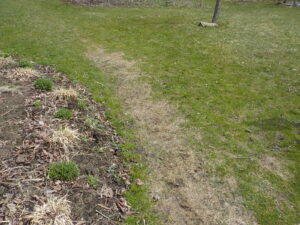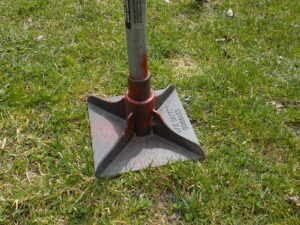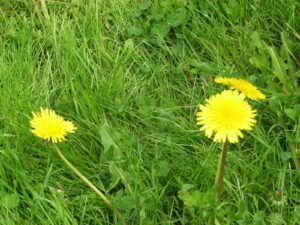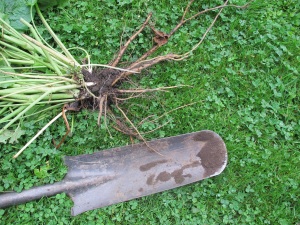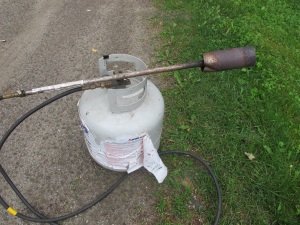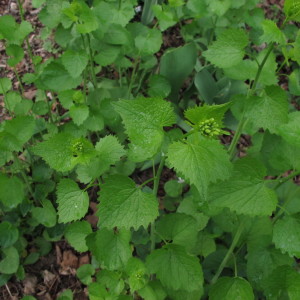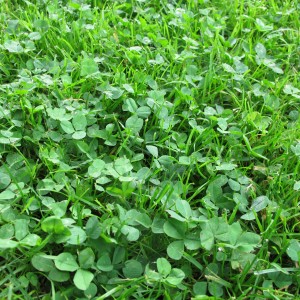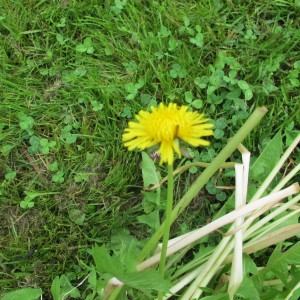Spring Lawn Care
To fix bare spots I use a short-tined garden rake to scuff up the soil. Then I scatter some seed with my hand, just sprinkling it over the spot. Next I sprinkle a thin layer of compost or fine garden soil over the seed. Not too much: most grasses need sunshine on the seed to germinate. Bury it with an inch of soil, and it won’t do well. Finally, pat it down with your foot, lightly, or with a metal tamper.
Let’s re-think the concept of a lawn. Why do we need a large patch of short grass at an even height all around our house? Sure, people with kids and dogs need some place to play ball or Frisbee. And if you like to have friends over and sit around a barbecue grill, a little lawn is nice. But do you really like mowing an acre of lawn once a week, or paying someone else to do it? Maybe it’s time to reduce the size of your lawn and plant some more native trees and shrubs.
In addition to the oaks, native cherry and willow trees, other “keystone” trees include birches, poplars (he calls them cottonwoods) and elm. He said just 5% of the genera of plants support 75% of the caterpillars. Great perennials include goldenrod (the absolute best), asters, and members of the sunflower family. There are many tame goldenrod species that will not take over your garden, so expand your plant palette to include “Fireworks” goldenrod and other nice varieties.
When you add grass seed to fill in spots, I recommend a mix of seeds, not a pure Kentucky bluegrass, which is the neediest of all grasses. It needs fertilizer, and watering. A “Conservation Mix” will do better for you. And if you are planting in a shady area, get a mix made for shady places. Those sun/shade mixes are not as good for shady areas as those designed for them.
Weeding
I love weeding. It creates order out of chaos, something I have come to appreciate. An un-weeded flower bed is full of distractions. My brain is constantly instant messaging me: “See that dandelion? You should pull it”. The weeds distract me from the beauty of the flowers and the texture and color of the leaves. I feel better as soon as I get my weeds pulled. That said, I still have weeds. Maybe I need to retire from writing a column!
Weeding also makes my plants thrive. Weeds compete with vegetables and flowers for sunshine, moisture, nitrogen and micro-nutrients. In the early spring when my perennials are just waking up, I am very careful not to yank their little green sprouts, thinking they are weeds. In fact, I often let some of my weeding go until late May or even mid-June when everything is obvious.
Dandelions, weeds that I don’t mind in the lawn, can get a bit rambunctious in the garden beds, and I pull them without compunction. Because they have a deep taproot, they are best pulled when the soil is moist. I use a long narrow shovel, one sold as a “drain spade” to loosen the soil down 12 to 16 inches. This spade is just 6 inches wide but the blade is16 inches long. I push the blade deep into the soil, pull back a little, then push it forward, and then slowly pull out the weed, the slower the better.
Sometimes I see a little dandelion and just grab it and pull – only to have the top break off while the roots remain. Whenever you leave dandelion roots, or even fragments of root, the plant will grow back.
Burdock and thistles also have tap roots, some going down very deep. The older the weed, the deeper the root. I’ve pulled mature burdock plants with roots nearly two feet deep. This is only possible when the soil is moist.
It’s really critical, especially for any weed that produces lots of seeds, that you not let them flower. If you don’t have time to dig them out, at least snip off the flowers. Many weeds have green flowers, and some will produce seeds even after being pulled if they have already formed flowers. I don’t throw noxious weeds, things like goutweed, in the compost pile for fear they will grow and spread – or leave seeds.
My favorite weeding tool is the CobraHead weeder (www.CobraHead.com). This is shaped like a tine on farmer’s cultivator – or a bent steel finger. I like it because it is narrow in profile and curved in a way that allows me to easily get the blade under the roots of a weed. I pull from below with the CobraHead while pulling the tops from above. I drag it through the soil in a bed after weeding and am always surprised by now many fragments of root it brings to the surface. I can use it with one hand or two. I use it for loosening the soil while planting, too. It is neither right- or left-handed, it is lightweight, and the handle is made from re-cycled plastic.
The CobraHead is great for teasing out long roots, too. I once pulled out a root 39 inches long in one piece, just gently loosening with the tool while tugging on the weed. That root was from a Queen of the Prairie (Filipendula rubra), a lovely pink-flowered perennial thug. It’s great for teasing out roots of invasive grasses.
Another great weeding tool is a favorite of my comic hero, Calvin, of Calvin and Hobbes. I refer to my flame thrower. It is technically a flame weeder, but Calvin and I refer to it as a flame thrower. It’s a metal wand on a 10-foot rubber hose attached to a propane tank normally used for gas grills. Light it, and it sends a flame out of the nozzle that will turn any weed crispy in an instant.
I often use my flame weeder on freshly turned soil. I let weed seeds germinate for a week or more, then burn them off before I plant. I try not to disturb the flamed soil when planting, as seeds that have been buried deeply will not germinate, but those on the surface, or near the surface will. Many weeds have what I call a photo-trigger. No light? They won’t germinate. Or I will flame, then plant seeds, then flame again before my carrots are up. Available from Johnny’s Selected Seeds or Fedco Seeds.
One of the worst weeds in the world is garlic mustard. Not only will it outcompete other plants in the understory, it can grow in full sun to full shade, and can produce many tens of thousands of seeds per square yard. Garlic mustard is also allelopathic, meaning that it produces chemicals that inhibit the growth of other plants and mycorrhizal fungi needed for healthy tree growth and tree seedling survival.
A friend last year hired a guy to pull all the garlic mustard under her trees and shrubs. It pulls easily, and he quickly filled wheelbarrows full of mature plants. But this year there were thousands of tiny garlic mustard seedlings popping up all over, even in the bark mulch he had put down. I lent him my flame weeder, and in no time he had burned off the small plants.
Many weeds can be deterred by a good thick layer of mulch. Seeds don’t germinate, or seedlings can’t push through the mulch, particularly if you lay down 4-6 sheets newspaper before mulching. Other, aggressive weeds will. Mature Japanese knotweed roots have been said to push through an asphalt driveway! Still, most garden weeds are really just enthusiastic plants that want to be your friends! My practice is to pull weeds every day, and that way I hope to finally beat them. Hah!
Henry is a garden writer, public speaker and garden consultant. He lives in Cornish Flat, NH. You may reach him at henry.homeyer@comcast.net.
Spring Lawn Care
I love lawns. Not big lawns, and they don’t need to be pure Kentucky bluegrass, either. I love a little bit of mowed green that has some grass and clover; it can have a few dandelions or bluets or violets, too. I can live with Creeping Charlie (also called ground ivy or by its scientific name, Glechoma hederacea). Overall my philosophy is this: if it’s green and you can mow it, it’s a lawn. Only thistles and other sharp things need to be dug out- but never nuked with chemicals.
Despite that philosophy, people often remark on how lush and thick my lawn is, and how nice it feels underfoot. Having a nice lawn is easy if you follow a few simple rules.
First, stop worrying about it. And certainly never add any chemicals to it. Weed-‘n’-feed formulas kill off not only the broad-leafed plants like dandelions, they also diminish the biological activity in the soil. I want a healthy soil full of microbes (including bacteria and fungi) and know that many microbes are killed or adversely affected by chemicals.
Chemical fertilizers are made of salts of nitrogen, phosphorus and potassium. These have the ability to dry out and kill microbes. And of course if your product includes chemicals for killing moss, weeds, fungi or insects, all those chemicals add to the killing power. Your soil cringes when you load up the spreader with weed-‘n’-feed.
If you want to have a good healthy lawn, you need good healthy soil. It needs about 6 inches of reasonably good soil that drains well (so as not to drown the lawn grasses) but is not so sandy that it dries out in an afternoon. Cut and peel back a one-foot square piece of sod after a rainstorm, and look at the soil. Grab a handful of soil. Does it form a cylinder in your hand when you squeeze it, and hold its shape when you open your fingers? If so, you have clay, or a clay-based soil.
If you perform the squeeze test on sandy soil, it will crumble apart when you open your fingers. When you rub the soil between your fingers, you will feel sharp grains of sand. But if you have a nice loam, the soil with be dark and the cylinder will fall apart if you touch it with a finger.
If you are not happy with your lawn, I suggest getting your soil tested. The Extension Service in most states will have on-line instructions on how to take a soil sample, and where to send it. Some garden centers have kits for sale. Find out what kind of soil you have, what it needs, and if your soil pH is in the right zone.
Soil pH is a measure of how acidic or alkaline your soil is. Lawns do best when the soil pH is near neutral (which is 7.0) or slightly acidic. Our rain is acidic, and neglected soils – including most lawns – have soil that is pretty acidic. You can fix this easily by adding limestone to the lawn, and a pH test will tell you how much to add to balance it out. If your soil is too far from neutral, some soil minerals will become unavailable to the grass plants, even if the minerals are there. You can add limestone at any time, though most lawn experts recommend the fall so that it will have time to do its work before spring growth begins.
The other additive that helps an anemic lawn is compost or organic matter. Good crumbly compost can be flung around the lawn with a shovel and then raked out to provide even coverage. Doing that now would help. Earthworms in a healthy lawn will be more than willing to eat that compost and then excrete the nutritious ingredients into the soil.
Earthworms, fungi and bacteria will also help you improve your lawn by breaking down your grass clippings. Those clippings will add organic matter and enrich your soil. So cut your lawn regularly – avoiding a thick layer of clippings that needs to be bagged or raked.
Lawn height is critical for a good, easy-care lawn. Get out of the golf course mindset. This is a lawn, not a putting green! I set my mower, generally, one notch down from the highest setting. Right by the front door I keep it a little shorter at times.
Why keep your lawn long? Your lawn is made of millions of plants, and each one can only create a healthy root system if you let it have enough blade to create its own food by photosynthesis. Too short? The roots will be stunted, and the lawn will not be healthy. And the taller the grass, the more it can shade out annual weeds and crabgrass.
Think about it: if there were daffodils that we could mow down only to have them bloom again, we would pay big bucks for them. But call those yellow flowers dandelions, and it’s war. I hope you’ll re-think your position about lawn chemicals if you’re in the weed-‘n’-feed school. Diversity of plant types in the lawn helps to create a lush, lovely green space.
Henry Homeyer is a garden designer and the author of 4 gardening books and a children’s chapter book. His Web site is www.Gardening-Guy.com.



